Offshore Wind
-
- Maritime Schools Must Prep for Offshore Wind Jobs Maritime Reporter, Nov 2019 #20
The offshore wind industry in the United States is growing exponentially, with multiple projects in the development stages off of the Atlantic coast. The total megawatt capacity of U.S. offshore wind farms is anticipated to reach 22,000 by 2030 and 43,000 by 2050. To support this growth, U.S. Department of Energy reports estimate over 40,000 new jobs will be created by 2030.
The new jobs anticipated to support the offshore wind industry include a wide range of types, including engineers, trade workers, surveyors, scientists, technicians, managers, and seafarers. Wind turbine technician has been one of the fastest growing occupations in the United States in recent years. The educational requirements for these new jobs also varies widely from high school diploma to Ph.D.
There is a growing concern that the United States will not have a sufficiently trained workforce capable to support offshore wind farm development, construction, and maintenance. A recent Department of Energy study focused on the Wind Energy Workforce in the United States highlighted the workforce gap issue. Although focused on land-based wind farms, the study identified significant gaps in wind and renewable energy educational programs and hiring percentages from those programs.
Development of Training and Safety Standards for Offshore Wind
The first step in ensuring a qualified workforce is determining what topics should be taught and what standards should apply. Many offshore wind companies mandate use of training standards developed by the Global Wind Organisation (GWO), a non-profit founded by wind turbine manufacturers and operators. GWO created training standards are implemented and taught by GWO-certified training providers. Currently six trainings are available, including: Basic Safety, Basic Technical, Advanced Rescue, Enhanced First Aid, Blade Repair, and Slinger Signaller. As these training classes have been critically reviewed by the worldwide offshore wind industry and mandated as the baseline safety training for employees of numerous internationally operating offshore wind operation and support companies, they are an important baseline for development of U.S. trainings.Although the baseline GWO trainings may be sufficient for some of the anticipated new positions, most will require some type of additional education, such as trade school certificates, undergraduate degrees, or even post-graduate level degrees.
Education and Development of the Offshore Wind Workforce Investment in Workforce Development
Concerned about the forecasted lack of U.S. citizens qualified to fill the projected offshore wind jobs, the United States and a number of states, as well as offshore wind developers have been taking action to invest in the education and development of a qualified offshore wind workforce. Federally, the Offshore Wind Jobs and Opportunity Act (the Job Act) was introduced this year and is currently pending in Congress. The Job Act would provide up to $25 million in federal grants to colleges, unions, and non-profits to prepare “a new generation of offshore wind workers.”
A number of states have also developed programs for offshore wind training and development programs. The Maryland Energy Administration introduced the Maryland Offshore Wind Workforce Training Program, which provides grant funding to training centers to “ensure Maryland has a ready and able workforce capable of contributing to the construction, installation, and operations & maintenance of an offshore wind energy project.” The program has a budget of $1.2 million for 2020.Massachusetts awarded $721,500 earlier this year to six academic institutions for offshore wind workforce training and development programs. One of the recipients is the Massachusetts Maritime Academy, which put the award towards funding construction of an offshore wind crew transfer training facility and establishing the GWO courses. The Academy aims to be the first institution in the United States to offer the GWO courses.
New York is working with the private industry to create an Offshore Wind Training Institute and created a $3 million Community and Workforce Benefits Fund to provide New Yorkers with the skills and safety training needed to participate in the offshore wind industry.
Finally, private offshore wind farm developers are investing in the education and development of their own future workforces in the United States. Offshore wind developer Vineyard Wind’s Windward Workforce program will “recruit, mentor, and train residents of Massachusetts, particularly southeast Massachusetts, for careers in the Commonwealth’s new offshore wind industry.” With $2 million dedicated to the program, it will be a partnership with vocational schools, universities, and associations. $200,000 of the awards made by Massachusetts came from this fund.
Ørsted and Eversource, partners in the Sunrise Wind development, have also committed to contribute $10 million to create a National Workforce Training Center in New York with Suffolk County Community College and leading labor unions.
Offshore Windfarm Training for the SeafarerA maritime industry trained and ready to engage in offshore wind farm construction is necessary to facilitate offshore wind development. Although a number of colleges and unions are providing classes and training on various aspects of offshore wind farm work, Massachusetts Maritime Academy is the only maritime school thus far creating courses and building resources specific to the seafarers’ role in this growing industry. Course development focused on offshore wind farm work and funding at other maritime colleges and trade schools is critically needed to ensure the availability of capable, experienced seafarers to support a growing offshore wind industry.
The Maritime Administration should take the lead in creating a new curriculum for offshore wind workers with training at Kings Point and the six state schools. MARAD should also engage with Congress on the Job Act to add a component for maritime workers and funding for their training at the above institutions. The U.S. Offshore Wind industry is growing and seafarers and their benefactors should take advantage of this growth with new programs graduating mariners ready to take on this role.
About the Authors
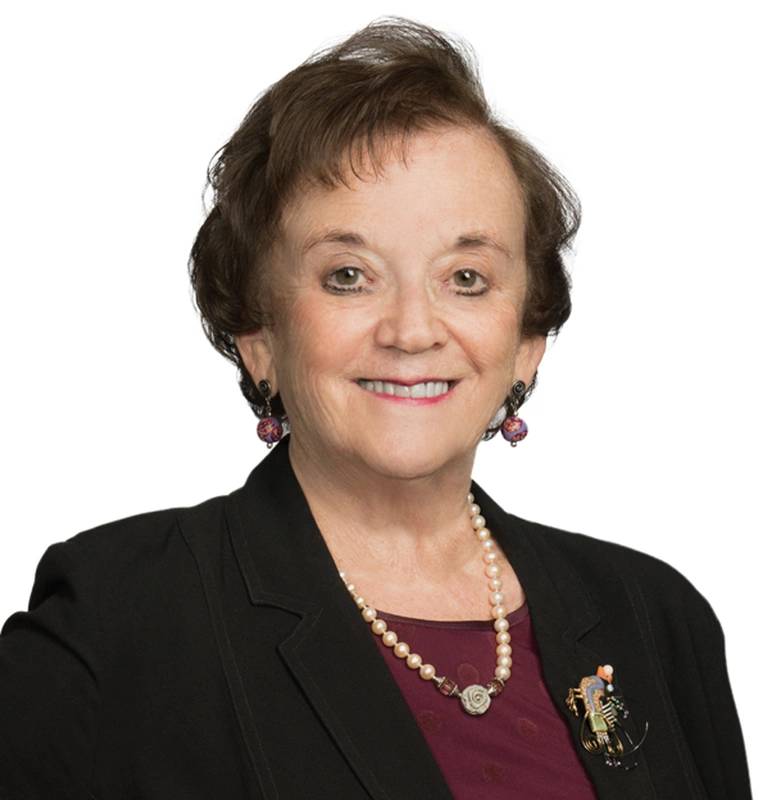 Joan Bondareff
Joan BondareffJoan Bondareff is of counsel in Blank Rome’s Washington, D.C., office who focuses her practice on marine transportation, environmental, regulatory, renewable energy, and legislative issues. She currently serves as Chair of the Virginia Offshore Wind Development Authority (VOWDA), an appointment by Virginia Governors Terry McAuliffe and Ralph Northam, where she promotes offshore wind and renewable energy for the Commonwealth of Virginia.
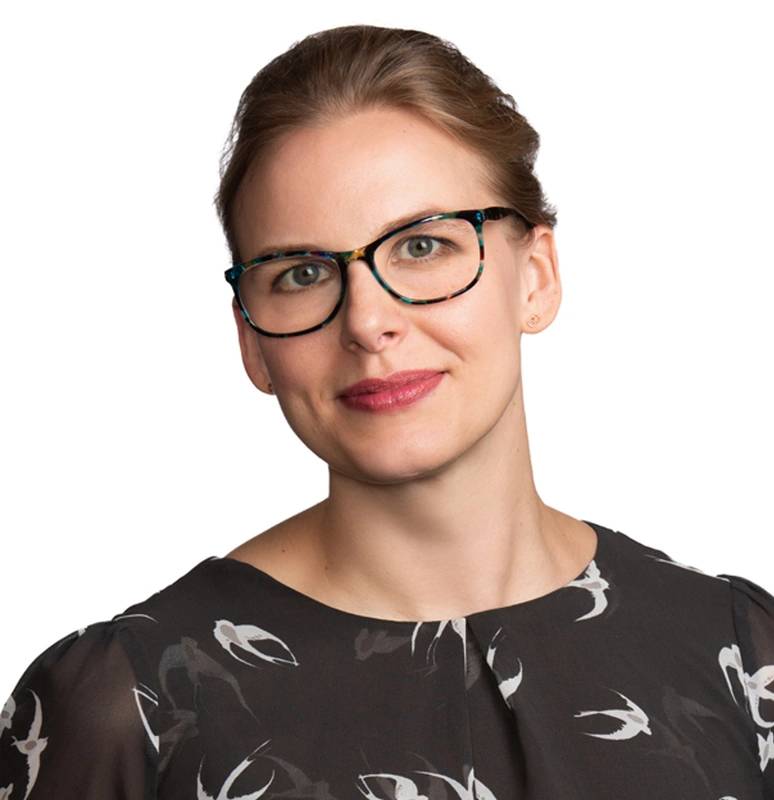 Dana Merkel
Dana MerkelDana Merkel is an associate at Blank Rome LLP and prior to joining Blank Rome, she worked through the International Organization of Masters, Mates, and Pilots as a Third Mate and Qualified Member of the Engine Department ("QMED") for several international shipping companies in the container, dry bulk, and tanker segments of the industry.
-
- Prepare Now for 40,000 Offshore Wind Jobs Maritime Reporter, Nov 2019 #20
The offshore wind industry in the United States is growing exponentially, with multiple projects in the development stages off of the Atlantic coast. The total megawatt capacity of U.S. offshore wind farms is anticipated to reach 22,000 by 2030 and 43,000 by 2050. To support this growth, U.S. Department of
-
- Favorable Offshore Winds Blowing from the Biden Administration Maritime Reporter, Apr 2021 #14
work cut out for them, as the goal of simply meeting the present Paris Climate Agreement goals may not reduce GHG emissions to the required levels.Offshore wind will be a critical part of reaching the new domestic and international climate goals. President Biden recognizes this fact in the EO by promising
-
- What to Expect from the US Offshore Wind Market This Year Maritime Reporter, Apr 2022 #18
After many false starts, the U.S. offshore wind market is building strong roots for a solid future. But as the market develops from its current northeast and mid-Atlantic niche new opportunities and challenges arise.The U.S. offshore wind market has long been seen as not delivering on its significant
-
- OP/ED: Offshore Wind Marine News, Sep 2019 #20
-- the Atlantic seaboard, with strong winds, a shallow continental shelf and a proximity to dense population centers is driving strong interest in offshore wind development. The offshore oil and gas supply chain stands to benefit in a big way from billions in coming investment. In fact, it is already playing
-
- Safely Navigating the Winds of Change Marine News, Jan 2020 #34
The first-in-the-nation offshore wind training facility will be located at the Massachusetts Maritime Academy.In late October, with much fanfare, Massachusetts Governor Charlie Baker, Stephen Pike, CEO of the Massachusetts Clean Energy Center and many others joined officials from the Massachusetts Maritime
-
- Offshore Wind Spend $20 Billion Per Year Marine Technology, Jul 2013 #32
Douglas-Westwood (DW) released the fifth edition of the World Offshore Wind Market publication where it forecast offshore wind installations averaging 3.2 GW per year over the next 10 years. Capital expenditure is expected to hit a peak of $24b in 2016. The market will remain highly concentrated in the
-
- Offshore Wind Market Report $19.8B Opportunity Maritime Reporter, Aug 2013 #30
Douglas-Westwood (DW) has released the fifth edition of the World Offshore Wind Market publication where we forecast offshore wind installations averaging 3.2 GW per year over the next 10 years. Capital expenditure is expected to hit a peak of €18B in 2016. The market will remain highly concentrated in the
-
- Top Five Trends in Offshore Wind Maritime Reporter, Apr 2018 #25
As technologies mature and dramatic cost-cutting continues, the future is looking bright for offshore wind. Below are five trends to keep an eye on.Follow the LeaderOffshore wind’s established leader, Europe, will continue to show the way forward and build capacity. At the end of 2016, nearly 88 percent of
-
- Top Five Trends in Offshore Wind Marine Technology, Apr 2018 #14
As technologies mature and dramatic cost-cutting continues, the future is looking bright for offshore wind. Below are five trends to keep an eye on.1. Follow the LeaderOffshore wind’s established leader, Europe, will continue to show the way forward and build capacity. At the end of 2016, nearly 88 percent
-
- The Headwinds of US Offshore Wind Development Marine News, Oct 2023 #15
On March 29, 2021, President Biden announced his ambitious plan to deploy 30 gigawatts (GW) of offshore wind power – enough energy to power 10 million U.S. homes – by 2030. The plan would leverage authorities under the Department of Interior, Energy, and Commerce to guide “more than $12
-
- MHI, Vestas Wind Joint Venture Underway Marine Technology, May 2014 #34
Offshore Wind A/S, a MHI, Vestas JV gets Underway In early May operations got underway at MHI Vestas Offshore Wind A/S, a new company dedicated to offshore wind turbine business jointly established by Mitsubishi Heavy Industries, Ltd. (MHI) and Vestas Wind Systems A/S (Vestas) of Denmark. The new joint-ventu
-
 )
March 2024 - Marine Technology Reporter page: 45
)
March 2024 - Marine Technology Reporter page: 45ronments. The new agreement will address speci? c techni- cal gaps in the UUV defense and offshore energy markets especially for long duration, multi-payload mission opera- tions where communications are often denied or restricted. As part of the new alliance, Metron’s Resilient Mission Autonomy portfolio
-
 )
March 2024 - Marine Technology Reporter page: 43
)
March 2024 - Marine Technology Reporter page: 43mega-booth at Oi, busy start to ? nish. Image courtesy Greg Trauthwein offers quality sub-bottom pro? ling capability without the need tion of offshore windfarms. GeoPulse 2 introduces new capa- for any dedicated transducers or cabinet of electronics. That bilities that enhance both its operation and
-
 )
March 2024 - Marine Technology Reporter page: 35
)
March 2024 - Marine Technology Reporter page: 35Figure 1 A self-righting vehicle design with buoyancy high and weight low, WHOI’s SeaBED AUV captures the attention of a pair of curious Antarctic penguins as it is deployed from the British research vessel James Clark Ross. Vehicle designers allowed for temperature reduction of battery capacity. Recharge
-
 )
March 2024 - Marine Technology Reporter page: 25
)
March 2024 - Marine Technology Reporter page: 25Auerbach explained that ideally, “one ? ed layers of geothermal activity,” noted changes over an area of 8,000 km2. They would have both instruments: seismom- Skett, “and the change in salinity and dis- found up to seven km3 of displaced ma- eters to detect and locate subsurface ac- solved particles for
-
 )
March 2024 - Marine Technology Reporter page: 20
)
March 2024 - Marine Technology Reporter page: 20Calendar January/Februay 2024 February 2024 March/April 2024 Ad close Jan.31 Ad close March 21 Ad close Feb. 4 Underwater Vehicle Annual Offshore Energy Digital Edition ?2?VKRUH:LQG$)ORDWLQJ)XWXUH ?2FHDQRJUDSKLF?QVWUXPHQWDWLRQ 6HQVRUV ?6XEVHD'HIHQVH ?6XEVHD'HIHQVH7KH+XQWIRU ?0DQLSXODWRU$UPV 7RRO
-
 )
March 2024 - Marine Technology Reporter page: 18
)
March 2024 - Marine Technology Reporter page: 18with stab surveys or dual TSS440) as the signals from the tracker do not affect the sen- cell ? eld gradient surveys. sor readings. This feature reduces offshore time as a pre-sur- Images courtesy FORCE Technology New version of FiGS in the inspection arm. 18 MTR #3 (18-33).indd 18 4/4/2024 8:59:50 A
-
 )
March 2024 - Marine Technology Reporter page: 16
)
March 2024 - Marine Technology Reporter page: 16and struc- replacements, which also aligns well with sustainable opera- tures from corrosion, is relatively straightforward. tional practices in the offshore industry. However, in order to Made of alloys like aluminum, Zinc and is some protect underwater assets effectively, the condition of CP an- T cases
-
 )
March 2024 - Marine Technology Reporter page: 14
)
March 2024 - Marine Technology Reporter page: 14speed of up to 3 knots. need for environmental monitoring, especially to track the “The Sentinel is the world’s fastest glider – its buoyancy impact of offshore construction on the ocean ecosystem, the engine is large enough to deal with large density changes in Sentinel can accommodate a greater number
-
 )
March 2024 - Marine Technology Reporter page: 4
)
March 2024 - Marine Technology Reporter page: 4of the Contributing Writers Kevin Hardy number of team members sent to speci? c events.. Celia Konowe We have media serving the global maritime, subsea, offshore energy, ports and logistics Edward Lundquist David Strachan markets, which in this context means that we attend a lot of exhibitions and conferences
-
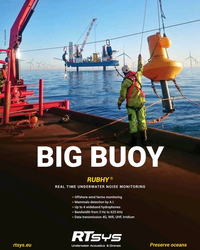 )
March 2024 - Marine Technology Reporter page: 1
)
March 2024 - Marine Technology Reporter page: 1Photo: Georgina Kelly BIG BUOY ® RUBHY REAL TIME UNDERWATER NOISE MONITORING > Offshore wind farms monitoring > Mammals detection by A.I. > Up to 4 wideband hydrophones > Bandwidth from 3 Hz to 625 kHz > (EXEXVERWQMWWMSR+;M?9,*-VVMHMYQ rtsys.eu Preserve oceans MTR #3 (1-17).indd 1 4/4/2024 8:47:57
-
 )
April 2024 - Maritime Reporter and Engineering News page: 48
)
April 2024 - Maritime Reporter and Engineering News page: 48Index page MR Apr2024:MN INDEX PAGE 4/5/2024 1:33 PM Page 1 ANCHORS & CHAINS MILITARY SONAR SYSTEMS tel:+44 (0) 1752 723330, [email protected] , www.siliconsensing.com Anchor Marine & Supply, INC., 6545 Lindbergh Houston, Massa Products Corporation, 280 Lincoln Street, SONAR TRANSDUCERS
-
 )
April 2024 - Maritime Reporter and Engineering News page: 47
)
April 2024 - Maritime Reporter and Engineering News page: 47ReducO on Chamber (206) 286-1817 www.merequipment.com QUALITY NACOL ACCUMULATORS • Forged shells, no welds • Long LasO ng, No Seam, Pleated Bladders OFFSHORE WIND • We stock 1/5 pint to 15 gallons in Chicago Log on to the • Sizes available to 40 gallons MARKET INTELLIGENCE MarineLink.com Intelatus offers
-
 )
April 2024 - Maritime Reporter and Engineering News page: 41
)
April 2024 - Maritime Reporter and Engineering News page: 41solutions speci? cally designed for use in harsh maritime environments: • GMDSS/NAVTEX/NAVDAT coastal surveillance and transmission systems • Offshore NDB non-directional radio beacon systems for oil platform, support vessel & wind farm applications • DGPS coastal differential global positioning
-
 )
April 2024 - Maritime Reporter and Engineering News page: 38
)
April 2024 - Maritime Reporter and Engineering News page: 38. the world's ? rst zero-emissions mooring service for a tanker. Equipped with two 150 kW engines and a lithium battery ca- This took place at an offshore multiple buoy mooring site near pacity of 485 kWh, Castalia ensures operational autonomy of the BP re? nery, two miles from the Port of Castellón
-
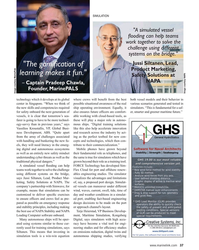 )
April 2024 - Maritime Reporter and Engineering News page: 37
)
April 2024 - Maritime Reporter and Engineering News page: 37tool. A simulated vessel ? ooding can help FORCE Technology has developed Sim- teams work together to solve the challenge Flex Cloud for port and offshore renew- using different systems on the bridge, ables engineering studies. The simulator says Jussi Siltanen, Lead, Product Mar- visualizes the advantages
-
 )
April 2024 - Maritime Reporter and Engineering News page: 35
)
April 2024 - Maritime Reporter and Engineering News page: 35certi? cation from ClassNK for Japan’s today is just eight seconds, one second less than gold? sh. The ? rst training program for crew members of offshore wind in- science behind these attention span perceptions is limited, but dustry crew transfer vessels (CTVs). The training uses the lat- educators
-
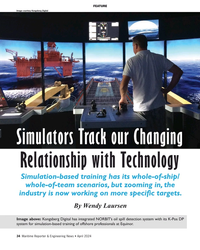 )
April 2024 - Maritime Reporter and Engineering News page: 34
)
April 2024 - Maritime Reporter and Engineering News page: 34Wendy Laursen Image above: Kongsberg Digital has integrated NORBIT’s oil spill detection system with its K-Pos DP system for simulation-based training of offshore professionals at Equinor. 34 Maritime Reporter & Engineering News • April 2024 MR #4 (34-44).indd 34 4/5/2024 8:43:52 A
-
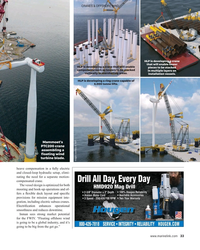 )
April 2024 - Maritime Reporter and Engineering News page: 33
)
April 2024 - Maritime Reporter and Engineering News page: 33CRANES & OFFSHORE WIND HLP is developing a crane that will enable tower HLP is developing a crane that will enable pieces to be stacked components such as towers to be stacked in multiple layers on vertically in marshalling areas. installation vessels. HLP is developing a ring crane capable of 6
-
 )
April 2024 - Maritime Reporter and Engineering News page: 32
)
April 2024 - Maritime Reporter and Engineering News page: 32of Mammoet requirement for the development of these cranes, particularly ling area. This would result in a major time and fuel saving. in ? oating offshore wind,” says Adrian Green, Engineering & For ? oating projects, it could reduce project installation time Contracts Director. “Ports are a major bottleneck
-
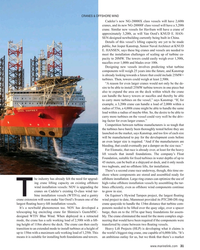 )
April 2024 - Maritime Reporter and Engineering News page: 31
)
April 2024 - Maritime Reporter and Engineering News page: 31CRANES & OFFSHORE WIND Cadeler’s new NG-20000X class vessels will have 2,600t cranes, and its new NG-20000F class vessel will have a 3,200t crane. Similar new vessels for Havfram will have a crane of approximately 3,200t, as will Van Oord’s KNUD E. HAN- SEN-designed newbuilding currently being built in
-
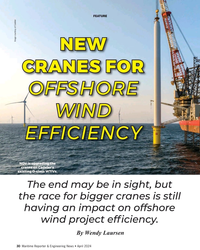 )
April 2024 - Maritime Reporter and Engineering News page: 30
)
April 2024 - Maritime Reporter and Engineering News page: 30FEATURE Image courtesy of Cadeler NEW CRANES FOR OFFSHORE WIND EFFICIENCY NOV is upgrading the cranes on Cadeler’s existing O-class WTIVs. The end may be in sight, but the race for bigger cranes is still having an impact on offshore wind project ef? ciency. By Wendy Laursen 30 Maritime Reporter
-
 )
April 2024 - Maritime Reporter and Engineering News page: 28
)
April 2024 - Maritime Reporter and Engineering News page: 28, we have ten container and roll on/roll off ships, two expeditionary transfer docks (ESDs) and four expeditionary sea base ships. We also have two offshore petro- leum distribution system ships that help move fuel ashore. Another ten preposition ships support the Army and Air Force. It should be pointed
-
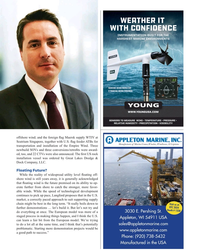 )
April 2024 - Maritime Reporter and Engineering News page: 23
)
April 2024 - Maritime Reporter and Engineering News page: 23offshore wind; and the foreign ? ag Maersk supply WTIV at Seatrium Singapore, together with U.S. ? ag feeder ATBs for transportation and installation of the Empire Wind. Three newbuild SOVs and three conversions/retro? ts were award- ed, too, and 22 CTVs were also announced. The ? rst US rock installa
-
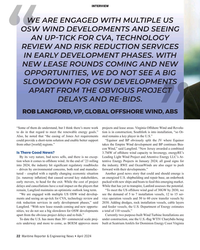 )
April 2024 - Maritime Reporter and Engineering News page: 22
)
April 2024 - Maritime Reporter and Engineering News page: 22NEW OPPORTUNITIES, WE DO NOT SEE A BIG SLOWDOWN FOR OSW DEVELOPMENTS APART FROM THE OBVIOUS PROJECT DELAYS AND RE-BIDS. ROB LANGFORD, VP, GLOBAL OFFSHORE WIND, ABS “Some of them do understand, but I think there’s more work projects and lease areas. Virginia Offshore Wind and Revolu- to do in that regard
